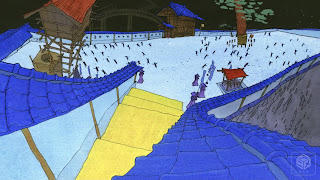THE REVOLUTION OF THE CHILD
Masaaki Yuasa's Night is Short, Walk on Girl
by Sumire Hayashi
 |
| The depiction of hot is visceral |
In recent years, Japanese animation has been pursuing realism with an increasing ferocity. You can see beautiful landscapes that look like 17th century French paintings, depictions of weather where you can almost feel the cold or hot and buildings that are closer to photographs than drawings. On the other hand, Masaaki Yuasa's style is characterized by crude, black outlines and characters drawn in monochromatic colors without highlights or shading. You wouldn’t call any of it realistic. The animation is flat with no three-dimensional effects. The characters he draws sometimes have pink, green or blue skin and there are extreme changes in body shape. But there is also a conviction to it, a sense that its crude-ness is an aesthetic choice rather than the work of an untalented hack.This is thanks to the unity of the worldview he depicts.
Every time I watch Night is Short, Walk on Girl, I want to watch it again. Yuasa creates an incredibly immersive world that you want to live in and it was so immersive that I wanted to read the novel on which it was based. When I read the novel, I found a different worldview than the anime. My first impression of the novel was that I had to go back a few pages and reread sentences to understand it. I have not read any other books by the author, Tomihiko Morimi, but it was clearly not as good as the movie. In fact, there is a huge difference between the two, and that difference between Yuasa’s film and the author’s book tells us a great deal about the distance between something that’s good and something that’s brilliant.
The biggest difference in the novel is that the story is divided into three chapters, and there is a flow of months and days. In the anime, the story is described as if it happens in one night. Yuasa’s compression of time improves the effects of the story in multiple ways. It's wild, exciting, original, and you never lose interest. It is a 93-minute film packed with a dense story depicted from Yuasa's own perspective.
He also uses a unique palette of saturated colors, shaky lines, and a strange slanted perspective to create a world of his own. There is a gorgeous and fun scene of a drinking contest; the hot pot is depicted with a limited red-black palette and Yuasa centers it on the burning fire. In the scene where the characters compare their endurance around a very spicy hot pot, their lips boldly swell up and sweat profusely as they take bite after bite of the hot pot ingredients. Colorful lines ripple across the screen in hallucinatory waves while the character suffers from the spicy foods. The way Yuasa captivates viewers is due to his attention to detail that takes us into a strange world.
After the hot pot scene, the story slips to a school festival scene that turns into a musical play. At first glance, they seem to have disparate subjects and disparate ways of expressing ideas, but they all come together very well. After watching the film, I was satisfied as if I had seen a couple of movies, and the main character in the film also describes it as "a strange night like a year." Each scene is connected in a natural flow and takes us to the next mysterious world without interrupting our feelings.
Instead of a diffused narrative that meanders along, he streamlines the tensions in the story and then gives that tension a visual language that pushes the narrative in stranger and new realms. This change makes this movie one and only. I felt that the trick of time passing
in this anime was not a forced change by Yuasa, but a respect for the original work and its title, Night Is Short, Walk On Girl. With this work, Yuasa has succeeded in taking an already popular work and bringing it to the world on a different level by making a few changes with his unique style.
These days, we are amazed by the photo-realistic animation produced mainly by the Japanese animation industry. Sometimes it feels as if the characters exist somewhere in the same world as you. It is a wonderful film style to express scenery that you have seen somewhere else, like an ordinary incident, or a trivial emotion in daily life, through animation. Sure, it's excellent, but does it remind us of that exciting feeling we had watching cartoons as a child? We have been thrilled and dazzled by saturated colors and light-hearted pacing of the stories. What we are lacking to live positively in today's sometimes cruel and harsh reality is the excitement that we left behind in our childhood.
Masaaki Yuasa's animations bring us adults into a world of wonder and nostalgia that reminds us of children's picture books. Some people may look at his painting style alone and say that it is childish and unacceptable. However, his works have a deep narrative that can only be understood as an adult. How about watching a movie that reminds you of the old days when you could genuinely enjoy a fun night that passed in a flash?
©Sumire Hayashi and the CCA Arts Review




No comments:
Post a Comment